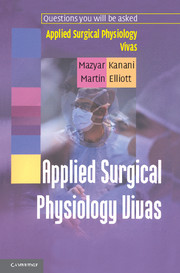Book contents
- Frontmatter
- Contents
- List of Abbreviations
- Dedication
- Preface
- A Change in Posture
- Acid-Base
- Action Potentials
- Adrenal Cortex I
- Adrenal Cortex II – Clinical Disorders
- Adrenal Medulla
- Arterial Pressure
- Autonomic Nervous System (ANS)
- Carbon Dioxide Transport
- Cardiac Cycle
- Cardiac Output (CO)
- Cell Signalling
- Cerebrospinal Fluid (CSF) and Cerebral Blood Flow
- Colon
- Control of Ventilation
- Coronary Circulation
- Fetal Circulation
- Glomerular Filtration and Renal Clearance
- Immobilization
- Liver
- Mechanics of Breathing I – Ventilation
- Mechanics of Breathing II – Respiratory Cycle
- Mechanics of Breathing III – Compliance and Elastance
- Mechanics of Breathing IV – Airway Resistance
- Microcirculation I
- Microcirculation II
- Micturition
- Motor Control
- Muscle I – Skeletal and Smooth Muscle
- Muscle II – Cardiac Muscle
- Nutrition: Basic Concepts
- Pancreas I – Endocrine Functions
- Pancreas II – Exocrine Functions
- Potassium Balance
- Proximal Tubule and Loop of Henle
- Pulmonary Blood Flow
- Renal Blood Flow (RBF)
- Respiratory Function Tests
- Small Intestine
- Sodium Balance
- Sodium and Water Balance
- Starvation
- Stomach I
- Stomach II – Applied Physiology
- Swallowing
- Synapses I – The Neuromuscular Junction (NMJ)
- Synapses II – Muscarinic Pharmacology
- Synapses III – Nicotinic Pharmacology
- Thyroid Gland
- Valsalva Manoeuvre
- Venous Pressure
- Ventilation/Perfusion Relationships
Stomach II – Applied Physiology
Published online by Cambridge University Press: 06 January 2010
- Frontmatter
- Contents
- List of Abbreviations
- Dedication
- Preface
- A Change in Posture
- Acid-Base
- Action Potentials
- Adrenal Cortex I
- Adrenal Cortex II – Clinical Disorders
- Adrenal Medulla
- Arterial Pressure
- Autonomic Nervous System (ANS)
- Carbon Dioxide Transport
- Cardiac Cycle
- Cardiac Output (CO)
- Cell Signalling
- Cerebrospinal Fluid (CSF) and Cerebral Blood Flow
- Colon
- Control of Ventilation
- Coronary Circulation
- Fetal Circulation
- Glomerular Filtration and Renal Clearance
- Immobilization
- Liver
- Mechanics of Breathing I – Ventilation
- Mechanics of Breathing II – Respiratory Cycle
- Mechanics of Breathing III – Compliance and Elastance
- Mechanics of Breathing IV – Airway Resistance
- Microcirculation I
- Microcirculation II
- Micturition
- Motor Control
- Muscle I – Skeletal and Smooth Muscle
- Muscle II – Cardiac Muscle
- Nutrition: Basic Concepts
- Pancreas I – Endocrine Functions
- Pancreas II – Exocrine Functions
- Potassium Balance
- Proximal Tubule and Loop of Henle
- Pulmonary Blood Flow
- Renal Blood Flow (RBF)
- Respiratory Function Tests
- Small Intestine
- Sodium Balance
- Sodium and Water Balance
- Starvation
- Stomach I
- Stomach II – Applied Physiology
- Swallowing
- Synapses I – The Neuromuscular Junction (NMJ)
- Synapses II – Muscarinic Pharmacology
- Synapses III – Nicotinic Pharmacology
- Thyroid Gland
- Valsalva Manoeuvre
- Venous Pressure
- Ventilation/Perfusion Relationships
Summary
1. Describe briefly the sources of gastric innervation.
Extrinsic supply: from the sympathetic and parasympathetic systems
Intrinsic supply: from the enteric nervous system
2. What is the autonomic supply?
Sympathetic: from the coeliac plexus. Reduces gastric motility
Parasympathetic: from the vagus nerve – causing increased motility
3. What is the storage capacity of the stomach?
1–2L.
4. How does the stomach accommodate this volume without painful distension?
It undergoes the process of receptive relaxation. This is a vagally mediated reflex where the fundus and the body relax when distending with food.
5. Apart from receptive relaxation, name some other important gastric reflexes.
Peristalsis: the basic electrical rhythm of the stomach generates slow waves that pass from inflow to outflow segments, propelling food
Retropulsion: when chyme is pushed backwards and forwards in the lumen. This helps to break up boluses
Emptying
Vomiting reflex
6. List the hormones which stimulate gastric emptying.
Gastrin: released from the gastric G-cells
CCK: from the duodenum
Secretin: also from the duodenum
7. What happens to the stomach during the process of vomiting? Outline the steps.
The process begins with a deep inspiration
This is followed by closure of the glottis
There is diffuse contraction of the abdominal and thoracic muscles. This elevates the pressures of both compartments. The intra-abdominal pressure may rise to 800 mm Hg
Simultaneously, there is relaxation of the lower oesophageal sphincter
There is a large retrograde contraction of the stomach, forcing the contents into the oesophagus following relaxation of the cricopharyngeus muscle
[…]
- Type
- Chapter
- Information
- Applied Surgical Physiology Vivas , pp. 152 - 154Publisher: Cambridge University PressPrint publication year: 2004



